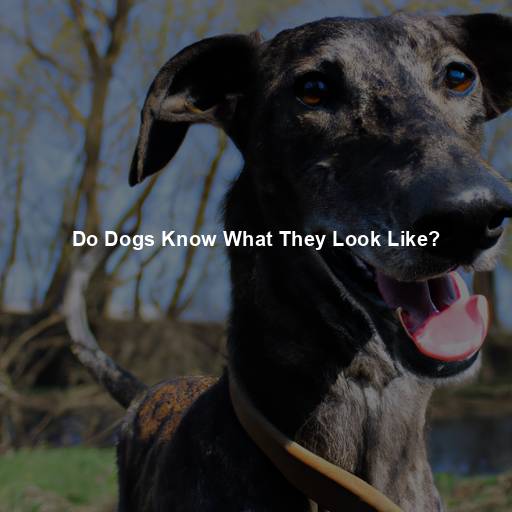Do Dogs Know What They Look Like?
Last Updated on November 24, 2023 by Evan
Contents
- 1 Exploring the Fascinating Concept of Canine Self-Awareness
- 1.1 Unraveling Self-Awareness: The Mirror Test
- 1.2 The Mirror Test and Dogs: Mixed Results
- 1.3 The Role of Socialization and Training
- 1.4 Cross-Species Comparisons: What We Can Learn from Primates
- 1.5 The Limitations of the Mirror Test
- 1.6 A Multifaceted Understanding of Canine Cognition
- 1.7 The Beauty of the Canine-Human Bond
- 1.8 Breed-Specific Traits and Behaviors
- 1.9 The Role of Genetics
- 1.10 Individual Variations and Learning Abilities
- 2 The Language of Scent: An Alternate Form of Self-Recognition
- 3 Beyond the Mirror: Other Measures of Self-Awareness
- 4 The Intricacies of Canine Cognition
- 5 Embracing the Wonder of Canine Cognition
- 6 FAQs – Do Dogs Know What They Look Like
Exploring the Fascinating Concept of Canine Self-Awareness
For centuries, dogs have been our faithful companions, filling our hearts with love and joy. But amidst the intriguing bond we share with them, have you ever pondered if dogs truly understand their own reflection? Do they possess the capacity for self-awareness? In this captivating article, we untangle the mysterious threads of canine cognition to uncover the fascinating truth: can our furry friends recognize themselves in the mirror?
Unraveling Self-Awareness: The Mirror Test
To understand whether dogs possess self-awareness, we turn to the widely known “mirror test”. This test, originally developed by psychologist Gordon Gallup Jr. in the 1970s, assesses an animal’s ability to recognize its own reflection in a mirror. It serves as an indicator of self-awareness, as the animal must understand that the image in the mirror is a reflection of itself.
The Mirror Test and Dogs: Mixed Results
The fascinating realm of dogs and the mirror test has left researchers in a state of perplexity. The findings, thus far, have been a burst of conflicting results, leaving us questioning the depth of their self-awareness. On one hand, certain studies imply that dogs possess a glimmer of self-recognition, but on the other hand, counterarguments suggest that their mirror behavior might be nothing more than a reaction to a perceived danger or a sheer inclination to explore the unknown. The enigma of canines and their relationship with their own reflection continues to puzzle scientists and dog enthusiasts alike.
The “Sniff Test”
One theory proposes that dogs may rely more on their sense of smell rather than visual recognition. They may use their olfactory senses to detect their own scent on objects or in the environment, thus establishing a sense of self-identity.
The Canine Communication Conundrum
Another factor to consider is the way dogs communicate with each other. Dogs primarily communicate through body language, scent, and vocalizations. Visual recognition may not hold the same significance for them as it does for humans.
The Role of Socialization and Training
When it comes to dogs and their self-perception, the mirror test is just one piece of the puzzle. While it offers intriguing glimpses into their minds, we mustn’t forget the bigger picture. Factors like socialization and rigorous training can greatly influence how dogs see themselves in the grand tapestry of their world. Let’s dive deeper into the mysterious realm of canine consciousness and explore the multifaceted nature of their self-awareness.
Body Awareness through Training
As canines undergo rigorous training, a fascinating phenomenon unfolds – a remarkable increase in their body awareness. Like unlocking a new level of perception, these dogs begin to comprehend their physical prowess and limitations, leading to an enhanced sense of self-awareness. It’s a perplexing journey that perplexes the mind and unveils the untapped potential within our furry companions.
Social Cues and Perception
When it comes to the fascinating world of dogs, their uncanny ability to read human behavior and signals never ceases to amaze us. The intricate dance we engage in with our four-legged companions plays a pivotal role in shaping their very sense of self. Nurturing their confidence through the power of positive reinforcement and heartfelt encouragement lays the foundation for a resilient and radiant self-image that radiates pure doggie bliss. So let’s embark on this enchanting journey, where our interactions and reactions create a symphony of understanding between dogs and their adoring humans.
Cross-Species Comparisons: What We Can Learn from Primates
To gain further insight into the concept of self-awareness in dogs, we can look to our closest relatives in the animal kingdom: primates. Studies conducted on great apes, such as chimpanzees and orangutans, have provided fascinating discoveries regarding their self-recognition abilities.
The Primate Connection
The fascinating world of primates never ceases to amaze, as they unravel the enigmatic mysteries of self-recognition through the mirror test. Much like their human counterparts, they engage in captivating behaviors like self-examination, intriguing self-directed actions, and even venturing into the uncharted territories of exploring concealed body parts. These remarkable feats of self-awareness continue to perplex and mesmerize scientists, painting a vivid portrait of the intricate nature of these intelligent creatures.
The Evolutionary Puzzle
Dwelling in the curious realm of canine complexity, one cannot help but ponder the enigmatic connection between dogs and their lupine forebears. Though bound by the ties of ancestral kinship and deeply rooted in sociality, the indeterminate nature of their self-awareness remains shrouded in an enigmatic tapestry. Wrought with the labyrinthine intricacies of evolutionary pathways, the transformative journey towards domestication has inevitably woven intricate threads of cognitive alteration, casting a hazy veil upon their intricately woven cognitive abilities.
The Limitations of the Mirror Test
The mirror test, renowned for its insightful exploration of self-awareness, has certainly shed light on various species. However, like everything in the intricate realm of science, it comes with a caveat. Skeptics have voiced concerns regarding its tendency to favor visually-inclined creatures like primates, potentially hindering a comprehensive understanding of cognitive capabilities across species. The enigma surrounding this debate continues to puzzle researchers and keeps the scientific community on its toes.
A Multifaceted Understanding of Canine Cognition
Exploring the enigmatic realm of canine cognition is a perplexing journey that demands our undivided attention. As we endeavor to unravel the intricacies of their inner world, we mustn’t be deceived by the deceptive simplicity of the mirror test. The wealth of canine intelligence goes beyond mere reflection, as these remarkable creatures divulge an awe-inspiring level of emotional sensitivity, suggesting a profound grasp of their own existence and the world that surrounds them.
Emotional Intelligence
The connection between dogs and humans goes beyond mere companionship. Dogs have an extraordinary knack for deciphering our emotions and reacting with a deep understanding and compassion. Their astute emotional intelligence reveals a profound self-awareness, allowing them to not only perceive but also adapt to the emotional rollercoasters we experience.
Problem-Solving and Adaptability
When it comes to dogs, it’s mind-boggling how effortlessly they tackle problems and adapt to different scenarios. Whether it’s mastering new commands or gracefully maneuvering through intricate surroundings, these furry geniuses reveal a stunning level of awareness and a profound understanding of their actions within specific contexts. Their cognitive prowess leaves us in awe and constantly wondering how they do it.
The Beauty of the Canine-Human Bond
There has always been a flurry of speculation surrounding the mirror-test for dogs, questioning their self-recognition skills. But let’s not allow this enigma to overshadow the undeniable connection we share with our canine companions. From their unconditional love to their loyal companionship, dogs continue to astound us with their ability to touch our hearts.
The Power of Connection
The bond forged between humans and dogs stretches far beyond the realm of mere visual acknowledgement. It is a profound connection rooted in trust, compassion, and an extraordinary language of adoration and camaraderie that defies the confines of self-awareness. This enigmatic relationship challenges our understanding, leaving us captivated by its intricacies and bewildered by its depth.
A Tale of Unconditional Love
Regardless of whether dogs can comprehend their own reflection, their impact on our lives is immeasurable. They teach us about loyalty, compassion, and the beauty of unconditional love.
Breed-Specific Traits and Behaviors
When it comes to our furry friends, some breeds seem to possess an uncanny knack for intelligence, trainability, and solving puzzles. It’s as if they possess an extra spark of self-awareness that sets them apart. The Border Collies, Golden Retrievers, and German Shepherds of the world are renowned for their impressive ability to grasp new concepts and adjust with lightning-fast speed.
The Role of Genetics
The fascinating world of dog cognition continues to reveal intriguing information. Recent research highlights the potential influence of genetics on a dog’s cognitive abilities. It appears that specific genes responsible for brain development and cognition can vary across different breeds, adding a layer of complexity to our understanding of how dogs perceive themselves and the world around them. These genetic variations may contribute to the unique cognitive differences observed among various canine companions.
Individual Variations and Learning Abilities
Just like humans, each dog has its unique personality, learning style, and cognitive strengths. Some dogs may naturally possess a higher level of self-awareness, while others may require more time and training to develop this ability. It is crucial to consider these individual variations when assessing a dog’s understanding of themselves.
The Language of Scent: An Alternate Form of Self-Recognition
Have you ever wondered how dogs actually perceive themselves? Well, it turns out that visual recognition through the mirror test may not be their go-to method. Instead, these furry beings have an awe-inspiring talent for sniffing out scents and deciphering their intricate messages. Scent is their secret language, revealing critical clues about their own identity and the fascinating world they inhabit.
Scents as Identity Markers
The remarkable world of dogs and their extraordinary sense of smell never ceases to astound. These furry companions rely on their snouts as their ultimate superpower, navigating through a universe of scents to identify everything from objects to animals, and yes, even individuals. Their highly attuned noses can unravel the most delicate variations in odor, enabling them to not only recognize their own scent, but also effortlessly differentiate it from the cacophony of smells around them. It’s almost as if they possess an alternate mode of self-recognition, granting them a one-of-a-kind connection to the world.
Scent-Marking Behavior
Have you ever wondered why your furry friend insists on leaving their mark all over everything? Well, it turns out that scent-marking is actually a pretty fascinating behavior observed in dogs. Through this seemingly strange act of depositing their own unique scent on objects and specific spots, our canine companions are actually staking their claim and asserting their sense of identity. It’s like they’re saying, “This is mine, and I want the world to know it”!
The Power of Familiar Scents
Have you ever noticed how dogs can seemingly navigate their environment with ease, relying on familiar scents like a compass guiding them through the unknown? It’s absolutely fascinating how they associate particular scents with specific individuals, animals, and even themselves. This uncanny ability to recognize familiar odors really makes you think about the level of self-awareness dogs possess. It’s almost as if they have an intricate map of scents etched in their minds, effortlessly deciphering their way through the world.
Beyond the Mirror: Other Measures of Self-Awareness
Exploring the depths of a dog’s self-awareness goes beyond the mirror test, unveiling a fascinating journey of discovery. Embracing alternative measures that push the boundaries of understanding, we unravel the enigmatic tapestry of their minds. Through intricate observations and thought-provoking analysis, a new realm of canine consciousness emerges, leaving us captivated and perplexed by their intricate sense of self. Diving into uncharted waters, we delve into the profound complexities of a dog’s identity, challenging conventional notions and unleashing a burst of tantalizing discoveries.
Body Awareness and Proprioception
Proprioception refers to a dog’s sense of body position and movement. Through training and physical activities, such as agility courses or obedience exercises, dogs develop a heightened sense of body awareness. This awareness not only aids in their physical coordination but also contributes to their overall understanding of themselves.
Understanding Cause and Effect
It’s truly fascinating how dogs display an uncanny knack for grasping cause and effect dynamics. They effortlessly connect their actions with the resulting outcomes or consequences, giving us a glimpse into their remarkable cognitive abilities. This kind of awareness hints at a sense of self-awareness, as they comprehend how their behavior directly impacts the world around them. The canine mind never ceases to surprise us with its complex understanding of the cause and effect relationship.
Empathy and Emotional Awareness
It’s absolutely fascinating how dogs have this incredible knack for picking up on our emotions, almost like they have a sixth sense for it. Whenever we’re feeling down or going through a tough time, they just seem to know, don’t they? It’s like they have this special ability to empathize with us, offering their unwavering support and providing a comforting presence that words can’t quite capture.
The Intricacies of Canine Cognition
While the question of whether dogs know what they look like remains unanswered, it is evident that their cognitive abilities extend beyond mere visual recognition. Dogs possess a remarkable capacity for communication, problem-solving, and emotional connection, all of which hint at a deeper level of self-awareness.
Communication through Body Language
Dogs rely heavily on non-verbal communication, using body language and facial expressions to convey their emotions and intentions. This ability to express and interpret subtle cues suggests a level of self-awareness and an understanding of their own body’s signals.
Problem-Solving Skills
Dogs exhibit impressive problem-solving skills, whether it’s figuring out how to open a door, locate a hidden treat, or navigate a complex environment. Their ability to assess situations, adapt their behavior, and find solutions indicates a level of self-awareness and the capacity to understand the consequences of their actions.
The Power of the Canine-Human Bond
Regardless of whether dogs possess a complete understanding of their own appearance, one thing is certain—the bond between humans and dogs is a remarkable testament to the power of connection. Dogs bring us joy, comfort, and unconditional love, enriching our lives in countless ways.
Embracing the Wonder of Canine Cognition
As we delve deeper into the fascinating realm of canine cognition, it becomes increasingly important to approach this subject matter with an insatiable sense of curiosity and a willingness to embrace the unknown. Though the mirror test fails to offer a definitive verdict on whether dogs possess self-awareness in the visual sense, it becomes evident that their perception of self goes beyond mere visual recognition. The enigmatic complexity of canine understanding continues to perplex and captivate researchers in this ever-evolving field.
Dogs are complex beings with unique personalities, emotions, and cognitive abilities. Their remarkable capacity for empathy, problem-solving, and communication showcases a level of self-awareness that may differ from our own, but is no less significant.
So, the next time you catch your furry friend gazing curiously into the mirror or displaying an uncanny understanding of your emotions, remember that their perception of self is a beautiful and intricate part of the extraordinary bond we share with our canine companions.
FAQs – Do Dogs Know What They Look Like
Can dogs recognize themselves in a mirror?
Dogs generally do not have the ability to recognize themselves in a mirror. While some animals, such as humans and certain primates, have self-awareness and can understand that they are looking at their own reflection, dogs lack this cognitive capability. When a dog sees its reflection in the mirror, it typically perceives it as another dog or an unfamiliar entity, rather than recognizing that the reflection represents itself.
Do dogs have a concept of their own appearance?
Although dogs may not comprehend their own appearance in the same way humans do, they still have a basic understanding of their physical presence. Through the senses of sight, smell, and touch, dogs build a familiarity with their body and develop an awareness of their size and shape. They can use their physical attributes to navigate through their environment and interact with other animals and objects effectively.
How do dogs identify each other?
The world of canine aroma is a fascinating and perplexing one. Dogs, with their remarkable olfactory prowess, navigate the scented pathways of identification and connection. Through an intricate dance of sniffing, they unravel the hidden messages embedded within their fellow canines, decoding a wealth of information nestled within the most unlikely body parts, igniting a symphony of gender, reproductive cues, and memories of past encounters. It is a realm where each whiff holds secrets and bonds, a testament to the extraordinary capacities of our four-legged companions.
Do dogs get confused by their reflection in water?
It is not uncommon for dogs to initially get confused by their reflection in water. Due to the unfamiliar perspective and the rippling effect, dogs might perceive the reflection as another dog or an object, leading to confusion or curiosity. However, most dogs quickly realize that it is their own reflection and become less interested or concerned over time.
Do dogs understand pictures or videos of themselves?
It’s a fascinating world we live in, where dogs, those beloved furry companions, navigate through life guided by their own unique set of instincts and perceptions. While they might exhibit moments of intrigue or recognition when faced with familiar sights or sounds on screens, it remains a perplexing notion to ponder whether they truly grasp the idea that these images or videos reflect their own existence. For these four-legged wonders, their reality is bound by the tangible realm, relying on their acute senses and direct interactions with the physical world to comprehend and make sense of things.
Can dogs recognize their own scent?
It’s absolutely fascinating to ponder over the profound abilities of dogs, particularly when it comes to their remarkable olfactory prowess. These incredible creatures possess a remarkable sense of smell that is unrivaled in the animal kingdom. This sensory superpower enables them not only to discern and distinguish various scents but also to remember and identify their own distinct odor amidst the cacophony of aromas in their surroundings. The significance of this extraordinary talent cannot be overstated, as it plays a pivotal role in their intricate social dynamics and communication within the canine community.







